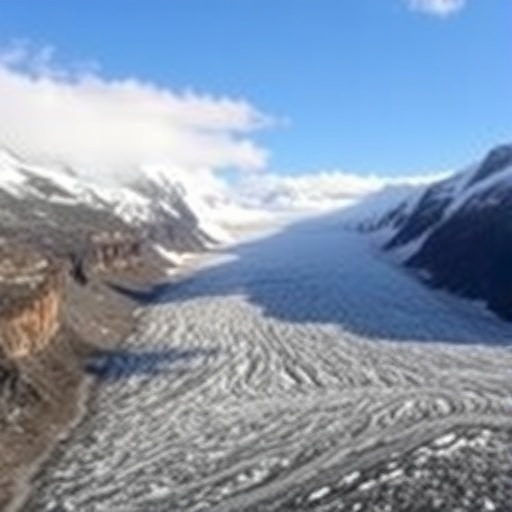An unprecedented international collaborative study has unveiled alarming projections for the future of Earth’s glaciers under prevailing climate policy commitments. The research indicates that by the year 2020 baseline, if nations maintain their current pledges towards limiting global warming, the planet’s glaciers are poised to lose approximately 76% of their mass. This stark figure derives from an advanced modeling effort involving multiple glacier models that simulate long-term glacier dynamics beyond conventional temporal boundaries, emphasizing the persistent and irreversible nature of ice loss in a warming world.
The anticipated global temperature rise under current national proposals is estimated to reach 4.9 degrees Fahrenheit (approximately 2.7 degrees Celsius) above preindustrial levels. This warming scenario triggers profound consequences not only for glacier volume but also for associated global systems. Among these repercussions are sea-level rise estimated to reach nearly nine inches, marked alterations in biodiversity as ecosystems reliant on glacial meltwater face disruptions, and a surge in natural hazards including floods and landslides attributable to the destabilization of mountainous ice masses.
Focusing on Alaska, one of the nineteen key glacier regions identified in the study, the findings project a glacier mass loss of around 69% under the present trajectory. Alaska holds the third-largest concentration of glacier ice globally, totaling roughly 16,246 gigatons, surpassed only by the Antarctic islands and northern Arctic Canada. This loss dramatically diminishes the region’s ice reserves, which have far-reaching implications for both regional hydrology and global sea-level contributions.
An encouraging aspect of the research reveals that adhering to the Paris Agreement’s lower warming threshold of 2.7 degrees Fahrenheit (1.5 degrees Celsius) could significantly mitigate glacier loss globally, lowering total ice mass reduction to around 47%. Correspondingly, Alaska’s glacier loss would be reduced to 41%, providing a stark demonstration that incremental climate action yields disproportionate benefits in glacier conservation and stabilization.
Professor Regine Hock of the University of Alaska Fairbanks and University of Oslo, a co-author of the study, highlights the critical concept of glacier “memory.” She explains that glaciers do not cease their retreat immediately once global warming is addressed; rather, they continue to lose mass for decades to millennia due to their delayed response to prior climatic conditions. This intrinsic inertia results in ongoing retreat until glaciers stabilize at elevations where temperatures are sufficiently cold to maintain equilibrium.
Fundamentally, this study departs from prior research methodologies by eliminating the arbitrary cutoff at the year 2100, which many earlier models employed. Instead, it simulates glacier mass balance until each individual glacier reaches a state of equilibrium, a dynamic steady state where seasonal ice gains exactly offset seasonal losses. This approach incorporates the complex time scales governing glacier response, capturing long-term melt processes that have historically been underestimated.
The equilibrium analysis indicates that Alaska’s glaciers, under the Paris Agreement’s low-end warming scenario, would take on average about 330 years to reach this steady-state condition. This extended timeframe reflects the prolonged influence of initial warming and accentuates the urgent need for preemptive climate mitigation to avoid locking in decades more of ice loss and its associated hazards.
The research was made possible through the Glacier Model Intercomparison Project (GlacierMIP), which unites a consortium of 21 scientists across 10 countries. Utilizing eight distinct glacier models, the project integrates a formidable dataset encompassing over 200,000 glaciers outside the Greenland and Antarctic ice sheets, thereby offering unprecedented coverage and statistical robustness. The collaborative nature of this initiative underscores the importance of cross-disciplinary verification and harmonization in climate impact assessments.
Crucially, the study also details glacier mass loss projections under varying global temperature increments, painting a comprehensive gradient of outcomes. At present conditions (2.1 degrees Fahrenheit warming), Alaska’s glaciers have already lost approximately 37% of their mass. Projected losses escalate with temperature: 41% at 2.7 degrees, 58% at 3.6 degrees, 69% at 4.9 degrees, 71% at 5.4 degrees, culminating in an 80% loss should warming reach 7.2 degrees Fahrenheit, a stark testament to the exponential sensitivity of glaciers to climate change.
Global glacier mass is similarly affected; total ice loss varies from 39% at current temperatures to a catastrophic 86% if warming escalates unchecked. These findings starkly quantify the non-linear and amplified risks associated with incremental increases in global temperature, elucidating the immense value in constraining warming even by fractions of a degree.
Harry Zekollari of the Vrije Universiteit Brussel, co-lead author, emphasizes the critical importance of immediate climate action. His remarks underscore the irreversible nature of glacier decline and how decisions made in the present will dictate glacier preservation for centuries to come. The research clearly signals that even marginal increases in temperature will substantially compromise the persistence of glaciers worldwide.
Complementing this perspective, Lilian Schuster from the University of Innsbruck elaborates on glaciers as sentinel indicators of climate change. Their retreat provides visible validation of global warming trends, yet their slow response times imply that current glacier sizes do not fully encapsulate the historic magnitude of climate disruptions already incurred. This lag effect means that glaciers are currently receding faster than their present mass loss would suggest, pointing to an exacerbating crisis.
The study aligns with global initiatives such as the Climate and Cryosphere Project and dovetails with the United Nations International Year of Glaciers’ Preservation. This synchronization amplifies the urgency and visibility of glacier conservation on the world stage, integrating scientific insights with policy frameworks that aim to preserve these vital components of Earth’s cryosphere.
In sum, this groundbreaking work delivers a pivotal message: the fate of glaciers is intertwined with global climate trajectories, and their ongoing decline reverberates across environmental and socio-economic domains. It reinforces the necessity of ambitious climate policies and highlights the complexities of glacier dynamics in a warming world—offering both a scientific roadmap and a clarion call to safeguard glaciers for generations ahead.
Subject of Research: Glacier mass loss projections and long-term equilibrium modeling under various global warming scenarios.
Article Title: Glacier preservation doubled by limiting warming to 1.5°C versus 2.7°C
News Publication Date: 29-May-2025
Web References: https://doi.org/10.1126/science.adu4675
Keywords: Glaciers, Climate change




